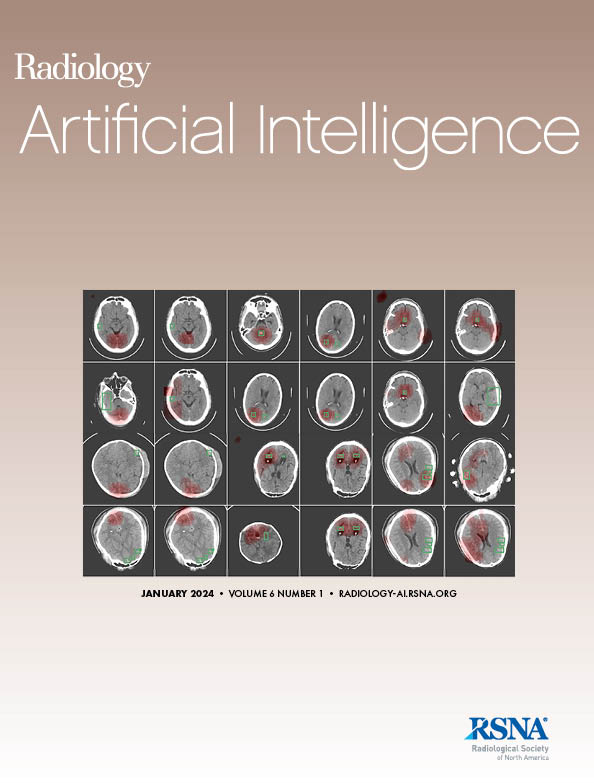Adaptive Dual-Task Deep Learning for Automated Thyroid Cancer Triaging at Screening US.
IF 13.2
Q1 COMPUTER SCIENCE, ARTIFICIAL INTELLIGENCE
Shao-Hong Wu, Ming-De Li, Wen-Juan Tong, Yi-Hao Liu, Rui Cui, Jin-Bo Hu, Mei-Qing Cheng, Wei-Ping Ke, Xin-Xin Lin, Jia-Yi Lv, Long-Zhong Liu, Jie Ren, Guang-Jian Liu, Hong Yang, Wei Wang
求助PDF
{"title":"Adaptive Dual-Task Deep Learning for Automated Thyroid Cancer Triaging at Screening US.","authors":"Shao-Hong Wu, Ming-De Li, Wen-Juan Tong, Yi-Hao Liu, Rui Cui, Jin-Bo Hu, Mei-Qing Cheng, Wei-Ping Ke, Xin-Xin Lin, Jia-Yi Lv, Long-Zhong Liu, Jie Ren, Guang-Jian Liu, Hong Yang, Wei Wang","doi":"10.1148/ryai.240271","DOIUrl":null,"url":null,"abstract":"<p><p>Purpose To develop an adaptive dual-task deep learning model (ThyNet-S) for detection and classification of thyroid lesions at US screening. Materials and Methods This retrospective study used a multicenter dataset comprising 35 008 thyroid US images of 23 294 individual examinations (mean age, 40.4 years ± 13.1 [SD]; 17 587 female) from seven medical centers from January 2009 to December 2021. Of these, 29 004 images were used for model development and 6004 images for validation. The model determined cancer risk for each image and automatically triaged images with normal thyroid and benign nodules by dynamically integrating lesion detection through pixel-level feature analysis and lesion classification through deep semantic features analysis. Diagnostic performance of screening assisted by the model (ThyNet-S triaged screening) and traditional screening (radiologists alone) was assessed by comparing sensitivity, specificity, accuracy, and area under the receiver operating characteristic curve using the McNemar test and DeLong test. The influence of ThyNet-S on radiologist workload and clinical decision-making was also assessed. Results ThyNet-S-assisted triaged screening achieved a higher area under the receiver operating characteristic curve than original screening with six senior and six junior radiologists (0.93 vs 0.91 and 0.92 vs 0.88, respectively; all <i>P</i> < .001). The model improved sensitivity for junior radiologists (88.2% vs 86.8%; <i>P</i> < .001). Notably, the model reduced radiologists' workload by triaging 60.4% of cases as not potentially malignant, which did not require further interpretation. The model simultaneously decreased the unnecessary fine needle aspiration rate from 38.7% to 14.9% and 11.5% when used independently or in combination with the Thyroid Imaging Reporting and Data System, respectively. Conclusion ThyNet-S improved the efficiency of thyroid cancer screening and optimized clinical decision-making. <b>Keywords:</b> Artificial Intelligence, Adaptive, Dual Task, Thyroid Cancer, Screening, Ultrasound <i>Supplemental material is available for this article.</i> © RSNA, 2025.</p>","PeriodicalId":29787,"journal":{"name":"Radiology-Artificial Intelligence","volume":" ","pages":"e240271"},"PeriodicalIF":13.2000,"publicationDate":"2025-05-01","publicationTypes":"Journal Article","fieldsOfStudy":null,"isOpenAccess":false,"openAccessPdf":"","citationCount":"0","resultStr":null,"platform":"Semanticscholar","paperid":null,"PeriodicalName":"Radiology-Artificial Intelligence","FirstCategoryId":"1085","ListUrlMain":"https://doi.org/10.1148/ryai.240271","RegionNum":0,"RegionCategory":null,"ArticlePicture":[],"TitleCN":null,"AbstractTextCN":null,"PMCID":null,"EPubDate":"","PubModel":"","JCR":"Q1","JCRName":"COMPUTER SCIENCE, ARTIFICIAL INTELLIGENCE","Score":null,"Total":0}
引用次数: 0
引用
批量引用
Abstract
Purpose To develop an adaptive dual-task deep learning model (ThyNet-S) for detection and classification of thyroid lesions at US screening. Materials and Methods This retrospective study used a multicenter dataset comprising 35 008 thyroid US images of 23 294 individual examinations (mean age, 40.4 years ± 13.1 [SD]; 17 587 female) from seven medical centers from January 2009 to December 2021. Of these, 29 004 images were used for model development and 6004 images for validation. The model determined cancer risk for each image and automatically triaged images with normal thyroid and benign nodules by dynamically integrating lesion detection through pixel-level feature analysis and lesion classification through deep semantic features analysis. Diagnostic performance of screening assisted by the model (ThyNet-S triaged screening) and traditional screening (radiologists alone) was assessed by comparing sensitivity, specificity, accuracy, and area under the receiver operating characteristic curve using the McNemar test and DeLong test. The influence of ThyNet-S on radiologist workload and clinical decision-making was also assessed. Results ThyNet-S-assisted triaged screening achieved a higher area under the receiver operating characteristic curve than original screening with six senior and six junior radiologists (0.93 vs 0.91 and 0.92 vs 0.88, respectively; all P < .001). The model improved sensitivity for junior radiologists (88.2% vs 86.8%; P < .001). Notably, the model reduced radiologists' workload by triaging 60.4% of cases as not potentially malignant, which did not require further interpretation. The model simultaneously decreased the unnecessary fine needle aspiration rate from 38.7% to 14.9% and 11.5% when used independently or in combination with the Thyroid Imaging Reporting and Data System, respectively. Conclusion ThyNet-S improved the efficiency of thyroid cancer screening and optimized clinical decision-making. Keywords: Artificial Intelligence, Adaptive, Dual Task, Thyroid Cancer, Screening, Ultrasound Supplemental material is available for this article. © RSNA, 2025.
自适应双任务深度学习用于筛查美国甲状腺癌的自动分类。
“刚刚接受”的论文经过了全面的同行评审,并已被接受发表在《放射学:人工智能》杂志上。这篇文章将经过编辑,布局和校样审查,然后在其最终版本出版。请注意,在最终编辑文章的制作过程中,可能会发现可能影响内容的错误。目的建立一种自适应双任务深度学习模型(ThyNet-S),用于超声筛查中甲状腺病变的检测和分类。材料与方法回顾性研究采用多中心数据集,包括2009年1月至2021年12月来自7个医疗中心的23294例个体检查(平均年龄40.4岁±13.1[SD], 17587例女性)的35008张甲状腺超声图像。其中,29004张图像用于模型开发,6004张图像用于验证。该模型通过像素级特征分析动态整合病变检测和深度语义特征分析的病变分类,确定每张图像的癌症风险,并自动对正常甲状腺结节和良性结节进行分类。通过比较McNemar试验和Delong试验的敏感性、特异性、准确性和AUC,评估模型辅助筛查(ThyNet-S分级筛查)和传统筛查(放射科医师单独筛查)的诊断性能。还评估了ThyNet-S对放射科医生工作量和临床决策的影响。结果6名高级放射科医师和6名初级放射科医师的thynet - s辅助分类筛查的AUC高于原始筛查(分别为0.93比0.91,0.92比0.88,P均< 0.001)。该模型提高了初级放射科医生的敏感性(88.2%对86.8%,P
本文章由计算机程序翻译,如有差异,请以英文原文为准。
来源期刊
期刊介绍:
Radiology: Artificial Intelligence is a bi-monthly publication that focuses on the emerging applications of machine learning and artificial intelligence in the field of imaging across various disciplines. This journal is available online and accepts multiple manuscript types, including Original Research, Technical Developments, Data Resources, Review articles, Editorials, Letters to the Editor and Replies, Special Reports, and AI in Brief.

 求助内容:
求助内容: 应助结果提醒方式:
应助结果提醒方式:


